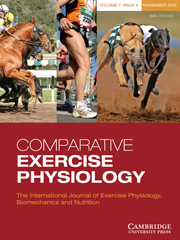Article contents
Girth tensions and their variability while standing and during exercise
Published online by Cambridge University Press: 28 March 2011
Abstract
The tension applied to the girth is usually based on an individual's experience rather than by scientific measurement or procedure. The equine thorax is a dynamic structure, and therefore the actual readings of girth tensions at rest and during exercise (actual tension) are likely to vary from the tension to which the girth was intended to be tightened at rest while standing (intended tension). This study was undertaken to determine the variability of girth tensions at rest and during exercise. A total of 19 Hanoverian horses were lunged on a 20 m circle in walk, trot and canter on both reins. In a randomized design, each horse was exposed to intended tensions 6, 10, 14 and 18 kg (saddle and girth at appropriate intended tensions). Girth tension was measured and recorded continuously using an in-line load cell. Intended girth tensions were not significantly different with mean actual girth tensions while standing. Actual girth tensions increased significantly (P < 0.001) between walk, trot and canter at all tensions except rest to trot at tension 6 kg, where the significance level was P < 0.01. Actual girth tension was significantly higher (P < 0.001) on the left rein at tension 14 kg in walk and trot, and at tensions 6, 10 and 14 kg during canter, and there was an overall trend for higher actual girth tensions on the left rein for the other tensions. As the thorax is a dynamic structure, girth tension variation could be due to multiple factors such as respiration, breath holding, muscular contraction, back flexion and extension, speed, gait and vertical acceleration of the saddle. Girth tension is a relatively new area of research, and as there are many opportunities for further research, a better understanding of the impact the girth has on the horse could help to improve performance and welfare.
- Type
- Research Paper
- Information
- Copyright
- Copyright © Cambridge University Press 2011
References
- 4
- Cited by


